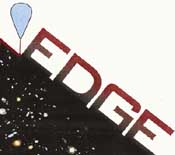NASA grant will help take astronomer to universe’s edge
By Steve KoppesNews Office
 |
Astronomer Stephan Meyer has received a two-year, $500,000 grant from the National Aeronautics and Space Administration to build a novel instrument that will look to the edge of the modern universe, where the first stars and galaxies began to shine.
The instrument will be a key component of an Antarctic balloon mission called the Explorer of Diffuse Galaxy Emission, or EDGE. The mission aims to trace the evolution and distribution of the very first galaxies, when the universe was only a few billion years old. With another round of funding, the mission could launch as early as 2007.
From studies of the cosmic microwave background radiation, the afterglow of the big bang, astrophysicists already know that matter during the first 300,000 years was almost evenly distributed. As time progressed, gravitational forces amplified small differences in the uniformity of matter to allow the formation of stars, galaxies and galaxy clusters.
Now astrophysicists seek to know how this evolution unfolded when the first objects were just beginning to shine. The light from these objects was absorbed by intergalactic dust clouds and then re-emitted at infrared wavelengths. This light, discovered with the Cosmic Background Explorer satellite in the mid-1990s, is called the cosmic infrared background.
Meyer’s instrument, called a frequency selective bolometer, will measure the temperature variations in the cosmic infrared background.
“A bolometer measures the simplest of things. It measures incoming radiation in the form of heat,” Meyer said.
A conventional bolometer is coated with a material that absorbs radiation in all colors or frequencies. Researchers have controlled the frequencies collected by placing a filter in front of the bolometer, whereas Meyer’s prototype incorporates the filters as part of the surface of the instrument.
“We need to make the best use of the telescope time we have,” Meyer said. “We fly this balloon for 10 days. We have to measure all colors in all positions as quickly as we can.”
![[Chronicle]](/images/small-header.gif)